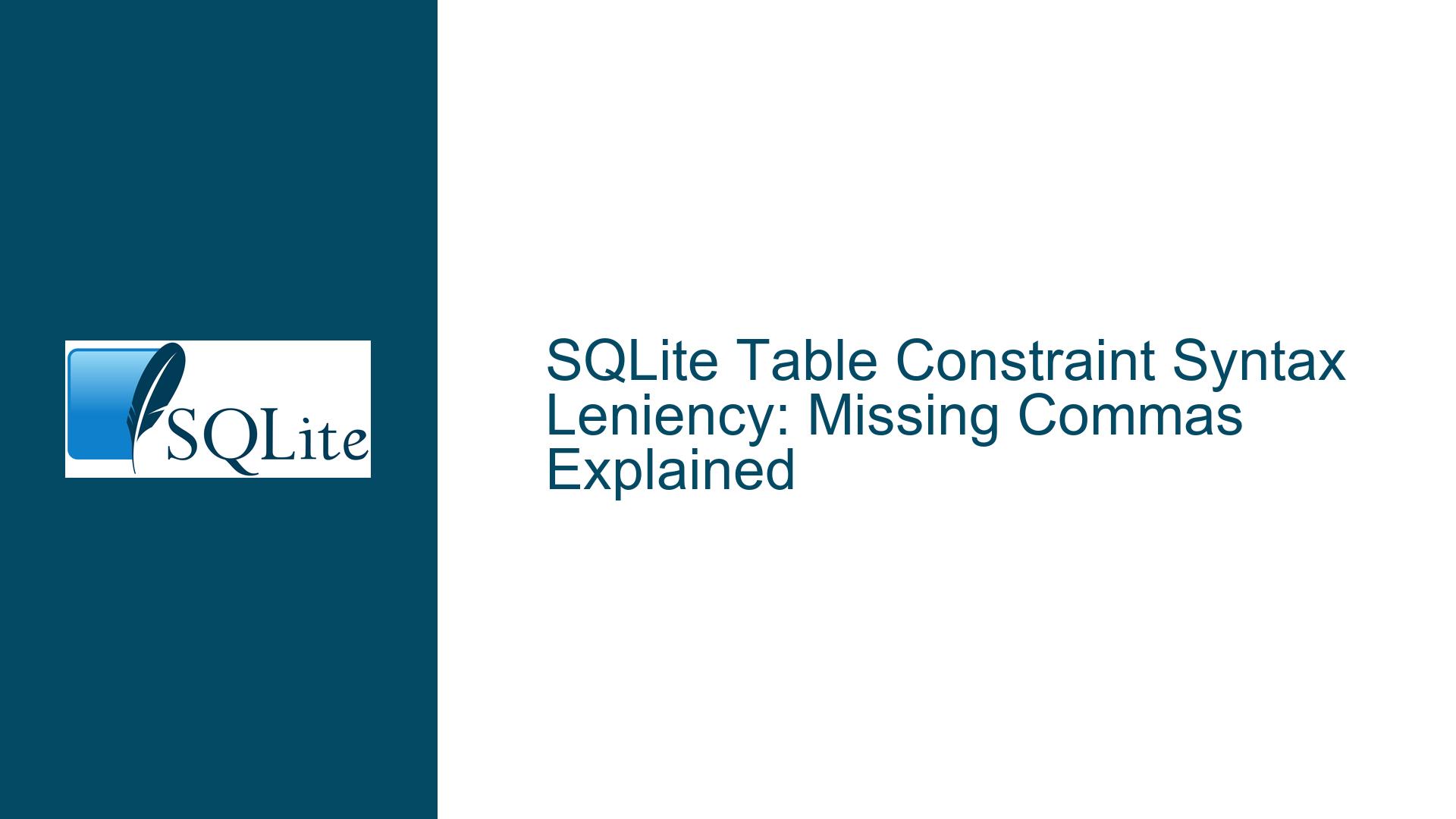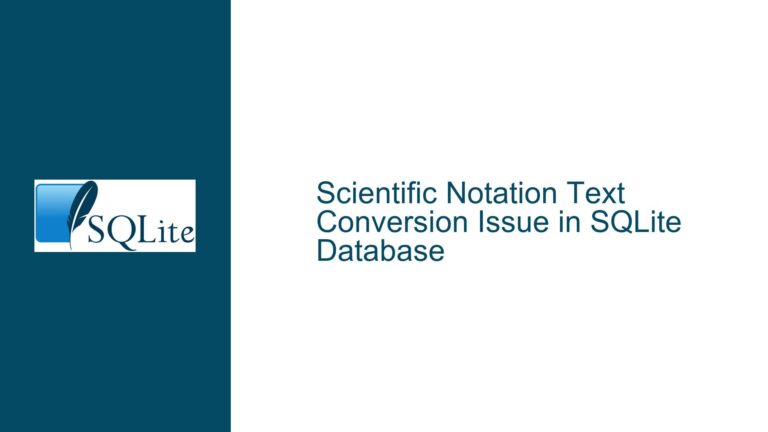SQLite Table Constraint Syntax Leniency: Missing Commas Explained
Unexpected Acceptance of Missing Commas in Table Constraint Definitions
The core issue revolves around SQLite’s handling of table constraints defined in CREATE TABLE statements. According to the official SQLite documentation, table constraints (such as CHECK, FOREIGN KEY, or UNIQUE clauses) must be placed after column definitions and separated by commas. However, SQLite does not enforce the requirement for commas between consecutive table constraints. This behavior allows schemas to be created with table constraints lacking commas, contrary to the documented syntax rules.
For example, the following statement executes without error despite omitting the comma between two CHECK constraints:
CREATE TABLE test (
id INT,
CHECK (id > 1) -- First table constraint
CHECK (id < 10) -- Second table constraint (no preceding comma)
);
Both constraints are enforced, as demonstrated by insertion attempts:
INSERT INTO test VALUES (1); -- Fails: "CHECK constraint failed: id > 1"
INSERT INTO test VALUES (11); -- Fails: "CHECK constraint failed: id < 10"
This contradicts the expectation that the CREATE TABLE statement should fail due to invalid syntax. The discrepancy arises from SQLite’s parser flexibility, which accepts omitted commas in this context. Developers relying on strict syntax validation or writing schema-parsing tools may encounter confusion, as the behavior deviates from both the documentation and conventions observed in other SQL dialects.
Key implications include:
- Schema Validation Ambiguity: Tools or scripts that validate SQLite schemas against the documented grammar may incorrectly flag valid (but comma-less) constraints as errors.
- Portability Risks: Schemas exploiting this leniency may fail on other database systems requiring strict comma separation.
- Parser Complexity: Developers implementing SQLite schema interpreters must account for this non-standard syntax.
Root Causes: Historical Design Choices and Parser Flexibility
The acceptance of missing commas stems from SQLite’s historical design philosophy prioritizing backward compatibility and robustness over strict syntax enforcement. When this behavior was first identified, it was classified as a harmless parsing quirk. Over time, however, the decision to retain it became intentional to avoid breaking existing applications or schemas that inadvertently omitted commas. This choice reflects SQLite’s broader emphasis on stability and tolerance for minor syntactic deviations.
Technical Parsing Mechanism
SQLite’s parser uses a look-ahead tokenizer to interpret schema definitions. When processing the CREATE TABLE clause, it identifies table constraints by keywords such as CHECK, FOREIGN, or UNIQUE. The parser does not strictly require commas between these constraints because it interprets the constraint keyword as a delimiter. This approach allows the parser to recover from missing commas by treating the next keyword as the start of a new constraint. For example:
CHECK (id > 1) CHECK (id < 10)
The parser detects the second CHECK keyword after the closing parenthesis of the first constraint, inferring a new constraint despite the missing comma. This logic is not explicitly documented but is consistent with SQLite’s error-recovery strategies.
Documentation vs. Implementation
The SQLite documentation’s syntax diagrams specify commas between table constraints, creating an expectation of strict adherence. However, the implementation deliberately diverges to accommodate real-world usage patterns. This divergence is not classified as a bug but as a documented-but-undocumented feature—a nuance clarified only through direct engagement with the SQLite team (as seen in the forum discussion).
Column Constraints vs. Table Constraints
A related point of confusion is the distinction between column constraints and table constraints. Column constraints are defined as part of a column definition and do not require commas beyond those separating column definitions. For example:
CREATE TABLE test (
id INT CHECK (id > 1), -- Column constraint
CHECK (id < 10) -- Table constraint
);
Here, the first CHECK is a column constraint attached to id INT, while the second is a table constraint. The parser’s leniency applies only to table constraints; column constraints cannot be followed by additional constraints without a comma.
Mitigation Strategies and Schema Validation Best Practices
To avoid ambiguity and ensure compatibility, adopt the following practices:
1. Explicit Comma Usage in Table Constraints
Always include commas between table constraints, even though SQLite does not enforce them:
CREATE TABLE test (
id INT,
CHECK (id > 1), -- Comma included
CHECK (id < 10) -- Comma optional but recommended
);
This aligns with the documented syntax and ensures portability to other database systems.
2. Schema Parsing Tool Adjustments
If developing tools to parse SQLite schemas, account for missing commas by:
- Tokenizing Constraints by Keywords: Identify the start of a new constraint using keywords (
CHECK,FOREIGN, etc.) rather than relying solely on commas. - Validation Modes: Offer strict and lenient parsing modes. Strict mode enforces commas per documentation, while lenient mode accommodates SQLite’s actual behavior.
3. Backward Compatibility Audits
Review existing schemas for missing commas using queries against sqlite_schema:
SELECT sql FROM sqlite_schema WHERE type = 'table';
Manually inspect the CREATE TABLE statements for table constraints lacking commas. While SQLite does not require fixes, addressing these inconsistencies improves schema clarity.
4. Documentation and Team Communication
Update internal documentation to reflect SQLite’s actual behavior. Educate team members on:
- The difference between column and table constraints.
- The intentional acceptance of missing commas in table constraints.
- Risks of relying on this behavior for cross-database compatibility.
5. Testing for Constraint Enforcement
Validate that constraints function as intended, regardless of comma usage. Execute test inserts to verify both positive and negative cases:
-- Should succeed
INSERT INTO test VALUES (5);
-- Should fail
INSERT INTO test VALUES (1);
INSERT INTO test VALUES (11);
6. Leveraging SQLite’s Error Logging
Use SQLite’s PRAGMA integrity_check and PRAGMA foreign_key_check to identify constraint-related issues in existing databases. While these do not directly address syntax leniency, they help uncover unintended constraint behaviors.
7. Community Engagement
Monitor SQLite’s official documentation and mailing lists for updates. The project’s maintainers occasionally revise parsing rules, and staying informed prevents surprises.
By understanding SQLite’s deliberate leniency, developers can write more robust schemas and tools while avoiding unnecessary confusion. This approach balances adherence to documentation with practical acceptance of real-world usage patterns.






